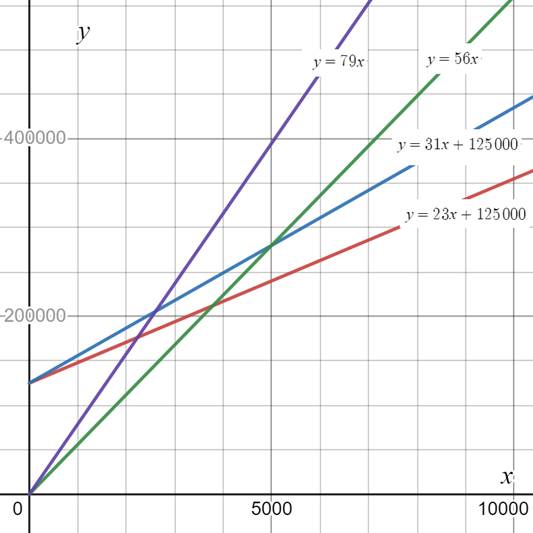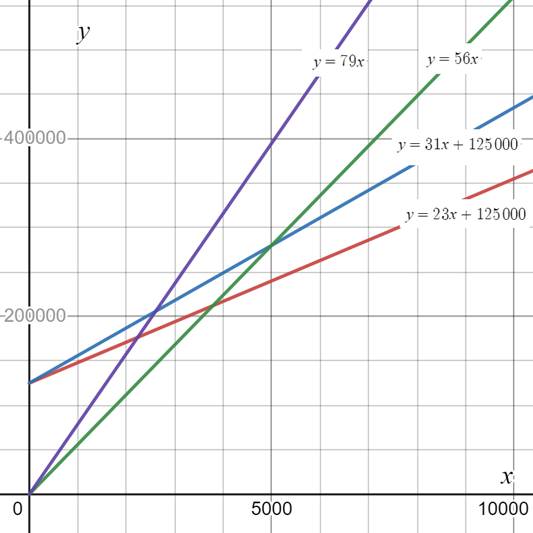
a.
To find: The function
The function that models the cost of producing
Given information:
The cost of making each unstrung racket is $23 and total of $125000 in fixed overhead costs.
Calculation:
Multiply the number of rackets with the price of each unstrung racket and add fixed overhead costs to get the function that models the cost of producing unstrung rackets as follows:
Conclusion:
The function that models the cost of producing
b.
To find: The function
The function that models the cost of producing
Given information:
The cost of making each unstrung racket is $23 and total of $125000 in fixed overhead costs.
Calculation:
Multiply the number of rackets with the price of each strung racket and add fixed overhead costs to get the function that models the cost of producing unstrung rackets as follows:
Conclusion:
The function that models the cost of producing
c.
To find: The function
The function modelling the revenue generated by selling
Given information:
The cost of making each unstrung racket is $23 and total of $125000 in fixed overhead costs.
The price of an unstrung racket is $56 and the price of a strung racket is $79.
Calculation:
The selling price of one unstrung racket is $56. So, the selling price of
Therefore, the function modelling the revenue generated by selling
Conclusion:
The revenue function is
d.
To find: The function
The function modelling the revenue generated by selling
Given information:
The cost of making each unstrung racket is $23 and total of $125000 in fixed overhead costs.
The price of an unstrung racket is $56 and the price of a strung racket is $79.
Calculation:
The selling price of one unstrung racket is $79. So, the selling price of
Therefore, the function modelling the revenue generated by selling
Conclusion:
The revenue function is
e.
To graph: The functions
Given information:
The cost of making each unstrung racket is $23 and total of $125000 in fixed overhead costs.
The price of an unstrung racket is $56 and the price of a strung racket is $79.
Graph:
Use a graphing tool to draw the graph of the functions as shown below.

Interpretation:
Selling strung rackets generates more revenue than selling unstrung rackets.
f.
To write: whether the company should manufacture unstrung or strung rackets.
The company should manufacture strung rackets.
Given information:
The cost of making each unstrung racket is $23 and total of $125000 in fixed overhead costs.
The price of an unstrung racket is $56 and the price of a strung racket is $79.
Calculation:
Consider the graph drawn in part (e).

From the graph it can be observed that the revenue generated by selling strung rackets is more than revenue generated by unstrung rackets. Thus, it is recommended to manufacture strung rackets.
Conclusion:
Selling strung rackets generates more revenue than selling unstrung rackets.
Chapter 1 Solutions
Precalculus: Graphical, Numerical, Algebraic Common Core 10th Edition
 Calculus: Early TranscendentalsCalculusISBN:9781285741550Author:James StewartPublisher:Cengage Learning
Calculus: Early TranscendentalsCalculusISBN:9781285741550Author:James StewartPublisher:Cengage Learning Thomas' Calculus (14th Edition)CalculusISBN:9780134438986Author:Joel R. Hass, Christopher E. Heil, Maurice D. WeirPublisher:PEARSON
Thomas' Calculus (14th Edition)CalculusISBN:9780134438986Author:Joel R. Hass, Christopher E. Heil, Maurice D. WeirPublisher:PEARSON Calculus: Early Transcendentals (3rd Edition)CalculusISBN:9780134763644Author:William L. Briggs, Lyle Cochran, Bernard Gillett, Eric SchulzPublisher:PEARSON
Calculus: Early Transcendentals (3rd Edition)CalculusISBN:9780134763644Author:William L. Briggs, Lyle Cochran, Bernard Gillett, Eric SchulzPublisher:PEARSON Calculus: Early TranscendentalsCalculusISBN:9781319050740Author:Jon Rogawski, Colin Adams, Robert FranzosaPublisher:W. H. Freeman
Calculus: Early TranscendentalsCalculusISBN:9781319050740Author:Jon Rogawski, Colin Adams, Robert FranzosaPublisher:W. H. Freeman
 Calculus: Early Transcendental FunctionsCalculusISBN:9781337552516Author:Ron Larson, Bruce H. EdwardsPublisher:Cengage Learning
Calculus: Early Transcendental FunctionsCalculusISBN:9781337552516Author:Ron Larson, Bruce H. EdwardsPublisher:Cengage Learning





